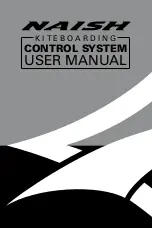
9
briefly and symmetrically pull on the brake lines and let go even when
the wing is still ahead of you.
Wing tangle
Of all the possible situations, which you may encounter while flying the
HOOK 3, this is the least probable one of all. The well proportioned ratio
and well calculated positioning of the line cascades ratify this fact.
A wing tangle may happen after an asymmetric collapse, the end of the
wing is trapped between the lines (Cravat). This situation could rapidly
cause the wing to turn, although it depends on the nature of the tangle.
The correction manoeuvres are the same as those applied in the case
of an asymmetrical collapse, control the turn tendency by applying the
opposite brake and lean your body against the turn. Then locate the line
that reaches the stabiliser that is trapped between the other lines. This
line has a different colour and belongs to the external lines of the C riser.
Pull on this line until it is tense, this should help to undo the wing tangle.
If you cannot undo the tangle, fly to the nearest possible landing spot,
control the flying course with your body movements and a little pressure
on the opposite brake. Be careful when attempting to undo a tangle if you
are flying near a mountainside or near to other paragliders, you may lose
control of the flying course and a collision may occur.
Over handling
Most flying incidents are caused by wrong actions of the pilot, which
chained one after another create abnormal flying configurations (a
cascade of incidents). You must to remember that over handling the wing
will lead to critical levels of functioning. The HOOK 3 is designed always
to try to recover normal flight by itself, do not try to over handle it.
Generally speaking, the reactions of the wing, that follow over handling,
are neither due to the input made or the intensity, but the length of time
the pilot continues to over handle. You have to allow the profile to re-
establish normal flight speed after any type of handling.
4.3 USING THE ACCELERATOR
The profile of the HOOK 3 has been designed to fly stable through its
entire speed range, the EN B certification confirms this. It is useful to
accelerate when flying in strong winds or in extreme descending air. When
you accelerate the wing, the profile becomes more sensitive to possible
turbulence and closer to a possible frontal collapse. If you feel a pressure
loss, you should stop pushing on the accelerator and pull slightly on the
brake lines to increase the angle of incidence. Remember that you have to
re-establish the flight speed after correcting the incidence.
It is NOT recommended to accelerate near to the mountainside or in very
turbulent conditions. If necessary you will have to constantly adjust the
movements and pressure on the accelerator whilst constantly adjusting
the pressure applied to the brake lines. This balance is considered to be
“active piloting.”
4.4 FLYING WITHOUT BRAKE LINES
If, for any reason at all, you cannot use the brake lines of your HOOK 3
you will have to pilot the wing using the C-risers and your body weight
to fly towards the nearest landing. The C-lines steer easily because
they are not under pressure, however you have to be careful not to over
handle them causing a stall or negative turn. To land you have to let the
wing fly at full speed and before reaching the ground you will have to
pull symmetrically on both the C-risers. This braking method is not as
effective as using the brake lines so you will land at a higher speed.
4.5 KNOTS IN FLIGHT
The best way to avoid these knots and tangles is to inspect the lines
before you inflate the wing for take-off. If you notice a knot before take-
off, immediately stop running and do not take off.
Содержание HOOK 3
Страница 1: ...USER S MANUAL HOOK 3...
Страница 16: ...16 11 3 RISERS ARRANGEMENT...
Страница 17: ...17 11 4 LINE PLAN...
Страница 24: ...The importance of small details niviuk com...










































